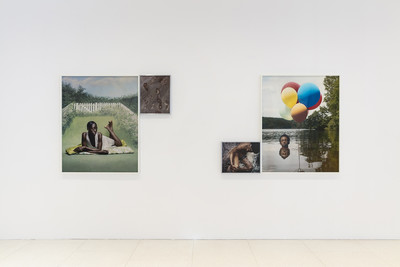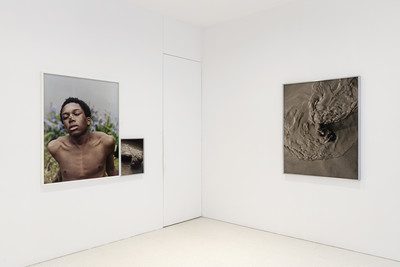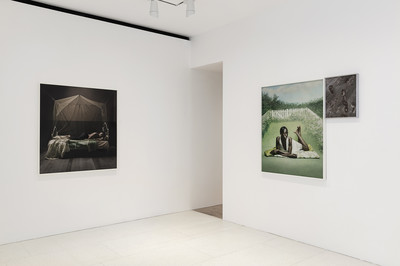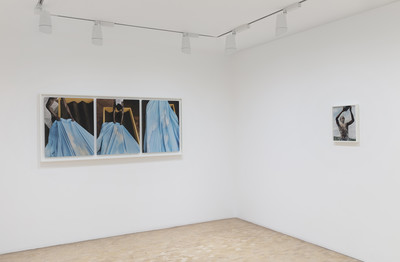As his sophomore exhibition entitled Chrysalis opens in Gagosian, photographer Tyler Mitchell is creating a new image-making vernacular.
By Rahim Attarzadeh
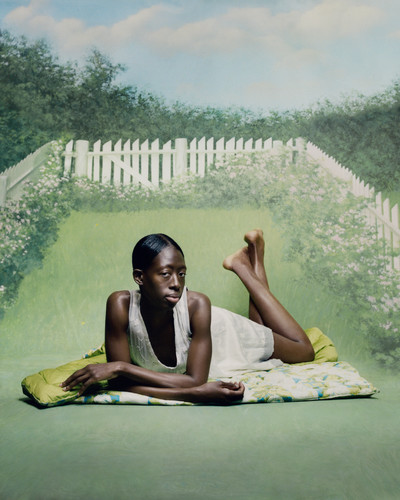
As his sophomore exhibition entitled Chrysalis opens in Gagosian, photographer Tyler Mitchell is creating a new image-making vernacular.
There are few young photographers today who are able to explain the motivations behind their work and make sense. Tyler Mitchell can do it with ease and he’s only 27 years old. Raised in Atlanta, Georgia and based in Brooklyn, New York, Mitchell has been creating a framework of desirability. Whilst everyone may already know Tyler rose to prominence as the first African American photographer to shoot an American Vogue cover (yes, it was Beyoncé), he’s elevated campaigns in JW Anderson (the models were on stilts) and he’s lectured at public institutions such as Harvard, but what others may not realise is that there is an immeasurable amount of detail that goes into every single one of his photos.
Mitchell wants you to consider the multi-layered approach that formulates his images before you consider who he’s shooting. His cutting and splicing techniques create a multiplicity-effect of racial construct. Each layer constructs a Tyler Mitchell image, where optimism is met with struggle to shine a light on the eminence of the Black Diaspora. An adjective he used to describe his work is ‘indelible’ and rightfully so – if you forget a Tyler Mitchell image, then perhaps photography wasn’t for you in the first place.
Whilst Mitchell has positioned himself as one of the most burgeoning talents in the realm of fashion photography, he has also mastered the sometimes self-sabotaging balancing act when it comes to contemporary art – something that many of his predecessors have failed to accomplish. Today, Mitchell’s Chrysalis exhibition opens in London’s Gagosian gallery and it’s already his second solo show to date. Curated by cultural ringmaster and Mitchell’s collaborative co-conspirator, Antwaun Sargent (also a director at Gagosian), the exhibition aestheticises Mitchell artistic duality when it comes to Black men, masculinity and nature.
Whilst the term Chrysalis typically depicts a state of evolution in insects, such as the splitting of an insect’s wings, Tyler wants you to use the term to stop and consider the transitional state in humans, and more specifically Black Americans. The notion of borders and restrictions become increasingly evident when one considers the image entitled Cage which shows a young Black woman lying in an idyllic landscape, but bordered by a stereotypically-American white picket fence. The image entitled A Glint of Possibility shows a young Black male on a tire swing, whilst staring into muddy waters. In both instances, the immediate sense of positivity shown through the subject’s body language in the images are met with a deeper state of restriction, or despair as shown through Tyler’s use of contrasted colours and borders.
System spoke to Mitchell about the visual dichotomy shown through his work, why he doesn’t like the term ‘nostalgia’ and how despite the stereotype surrounding an artist’s sophomore show, Tyler Mitchell’s Chrysalis exhibition is anything but boring.
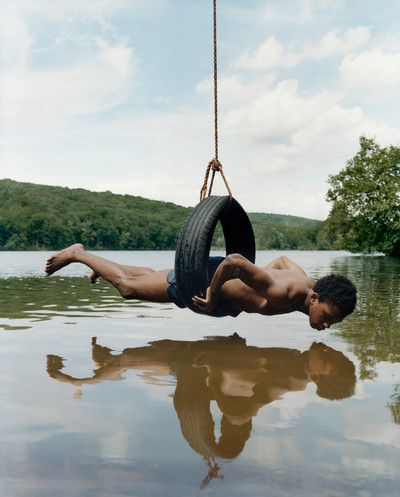
Before we talk about your Chrysalis exhibition at Gagosian, would you say your work as a fine artist bears the same level of consistency as it does with your fashion photography?
Tyler Mitchell: I like to think of myself as an artist who is working across the borders of art and fashion. I’ve developed this language which has become signature and that’s exciting. The fashion realm is very much characterised by a rich sense of colour and a certain brightness. I’m able to add layers of that with art photography. Beauty is the hook to what I’m trying to accomplish. I think I’ve made that pretty clear within my work.
How did the exhibition come about?
Tyler Mitchell: The show itself came through my friend Antwaun Sargent, who’s now a director at Gagosian. We’ve also worked together on the New Black Vanguard exhibition coming up later this month. I’ve had a personal relationship with him for the past five years. He understands the visual language surrounding my images.
On first appearance, the exhibition certainly subscribes to the general moniker of beauty and nature, but what lies behind this feels like a far more personal, twisted and nuanced point of view. Your images have this arresting multi-scaffolding, or layered effect. How do you go about assembling each image and each layer? Is the effect intentional, or a result of your creative process?
Tyler Mitchell: I’ve been more interested in the ideas of beauty and the way in which that plays out in fashion. In art, the notion of beauty is a way of symbolising an idyllic world, or a world in which a public space is able to be freely inhabited. Being a young Black man travelling and moving freely around the world has enabled me to garner these different experiences through my work. Whether that be in Europe, New York, or back home in Atlanta. The notion of travelling freely and illustrating that in my work is intentional. The exhibition conveys a multilayered approach, exploring the way in which Black men can psychologically inhabit space freely. At the root of it all, it’s really a question of power – who is able to liberate themselves or feel like they have a sense of agency within those spaces.
‘To a degree, I’m always challenging notions of conformity. That’s what artists do.’
You’re from Atlanta, Georgia. How important is the notion of domesticity in your work? Is that something you try to incorporate more in your fine art photography, rather than your fashion photography?
Tyler Mitchell: I think on some level, any artist wants their work to be distinctly global – the ability to start a conversation anywhere in the world. However, being that I’m from Georgia, that’s going to be a part of everything I make. My first show ever was at Foam in Amsterdam called I Can Make You Feel Good. Dutch people were coming up to me about how the images reminded them of some of their own personal experiences. I like to think that’s what photography does. It’s open to interpretation so that people can bring their own projected experiences to the work. I hope that this show achieves the same result as my first one in Amsterdam. When Antwaun contacted me to do this in England, I didn’t feel the need to change who I am creatively. I always want to be myself.
In terms of the title of the exhibition, aside from its connection to nature and the splitting of an insect’s wings, for instance from a caterpillar to a butterfly, the term Chrysalis is one that depicts a transitional state in humans – in your case more specifically when it comes to Black masculinity. Can you expand on this intrinsic transition and how that comes across in your work?
Tyler Mitchell: I’m 27 now and it’s a funny age. You’re well into adulthood and independence. If 18 is the signal event, then 27 is the age of independence. A lot of people say 27 is the age where you rethink it all. I’m at a stage in my career where this is my second gallery show, and it’s a sophomore show. There’s all these stereotypes around the sophomore show being the hardest one; they call it the ‘sophomore slump.’ Everyone loves the first thing you do but everyone also loves something new. Nobody cares about the second instalment. I’m really invested and interested in this show not alluding or directly talking about those elements. I want it to be a metaphor for my own trajectory; garnering a long career for myself and hopefully along the way, encouraging the systems we all operate in to foster and support the ambitions of young black photographers and artists. That’s in tandem with how the exhibition shows a state of evolution within Black men and Black masculinity. So, now coming to London feels very different compared to when I was in my teens and early twenties, having meetings with Dazed, or i-D and trying to become a professional photographer. It made me feel quite different being a Black American, rather than a Black Brit. I was hanging out with Ib Kamara and Campbell Addy and so many other people. Whilst I love them, because of our backgrounds, we’re very different. I thought we were all the same before coming here, but I realised that wasn’t the case.
Speaking of different points of view, let’s discuss the metaphorical contrast within your work. It is demonstrated through the blue skies and muddy waters in Chrysalis – was that intentional? Do you feel that as a Black creative, optimism will always be negated with a form of negativity?
Tyler Mitchell: I made a book called I Can Make You Feel Good, which was explicitly about this idea of unburdened images. Images that we weren’t used to seeing, especially when it relates to Black existence. It was all about welcoming the range of emotions that comes with being a human being. I think you can see that in all of my work. There’s more overtly eerie underpinnings within Chrysalis, whether it’s combating the connotations of mud, or the tire swings. To a degree, I’m always challenging notions of conformity. That’s what artists do. I think the exhibition challenged the notion that there can be a successful widespread gallery of imagery that exhibits unburdened Black presence. There will always be struggles. The art practice allows me to explore these metaphors and storytelling elements more vividly.
‘The exhibition conveys a multilayered approach, exploring the way in which Black men can psychologically inhabit space freely. At the root of it all, it’s really a question of power – who is able to liberate themselves or feel like they have a sense of agency within those spaces.’
Would you say that the human condition and exploring its ebbs and flows lay the foundations of your creative approach?
Tyler Mitchell: It’s always been about the human condition. The way my brain works is cinematic. It’s similar to the way in which we understand how information is presented to us in films. It’s the visual arrangement – there’s a sonic component and of course the visuals and the script. What really speaks to me is if you see someone framed very small and very alone in a very busy full café, you will immediately understand that the director wants to hone in on this element of isolation. Let’s just take that metaphor. I started to understand that photographs and films could arrange themselves as visual metaphors. For me nowadays, I find myself more and more interested in metaphors around humans, metaphors around storytelling and the human condition itself. Fashion is more centred on who’s considered beautiful, or what’s beautiful, or what’s at the centre of beauty. Who are the protagonists of beauty? Art allows me to create my own iterations of beauty, not bound by an industry of opinion. It’s exciting to me.
Nature also seems to be a fundamental component of your work. You mentioned that the exhibition is partly a commentary on the relationship between Black people and nature and the restrictions associated with this, or the outdoors in general. Can you expand on these restrictions?
Tyler Mitchell: There are social, historical and political restrictions. The images I’ve been creating call for a variety of connotations. Especially in America, where governmental systems have put restrictions in place when it comes to redlining, gerrymandering, or redistricting. Systems of power have redrawn districts and have commandeered land to prevent Black people, brown people and oppressed people from moving through land to vote. I’m not an activist. I’m not standing here campaigning for the drawing of District X, Y, or Z in Georgia. I’m addressing this in a subliminal and visual way. When we see images of young Black men and women in landscapes, whether those be in England, or New York, or Georgia, or Lagos, we automatically believe there is an implied sense of freedom in their ability to command that space. My work deciphers through all of those elements. I want my work to be part of a world where we are confronted with the idea of seeing Black people freely inhabit land.
How does your approach to the exhibition differ from how you go about working in fashion? Would you say that Chrysalis shows a less idealistic but more realistic insight into the struggles of Black people? Whereas fashion is more about optimism. If fashion photography could reveal an emergence from struggle, then this is more about showing the process of struggle itself? It’s imminence versus eminence.
Tyler Mitchell: I’m hoping my work shows under the same umbrella in that I don’t want to change who I am just because I’m a fashion photographer. When I did some of my first collaborations with Jonathan Anderson – who I love working with because he’s so open-minded – I took the idea, which was surreal, theatrical and playful, of shooting a bunch of women who have never been shot before. They were the protagonists. It didn’t feel like a high fashion campaign. I elevated them by putting them on stilts in the middle of the British countryside. I already knew that would be a striking image to a certain degree. I also like to insert new protagonists into my work – whether that be for a JW Anderson campaign or an exhibition at Gagosian. It’s what you said – eminence.
I’m also tired of nostalgia. As an artist, I’m trying to create things that are new and exciting.’
There is a knowing familiarity to a lot of the aesthetic you conjure up within your work. It’s also shining a light on the Black diaspora which is a period that has existed in the dark for too long. To what extent does nostalgia play a part in your approach to fashion and image-making in general? For example, the tire swing in the Chrysalis exhibition was something from your childhood.
Tyler Mitchell: I have a tense, or contentious relationship with the word nostalgia. It’s complicated for me because nostalgia implies you are comfortable, right? It reminds you of things you have experienced in the past. I’m also tired of nostalgia. As an artist, I’m trying to create things that are new and exciting. I hope all artists are trying to do the same thing. Art has to reflect upon the society we live in today - that way it opens up a more universal conversation. What I’m about to say next is a bit out there!
We like out there at System!
Tyler Mitchell: I know you do! For me, fashion is constantly dealing with what’s contemporary. I’ve put out work that is fixated on the varying notions of beauty. I’m interested in beauty that can be timeless. But often nostalgia implies an instance that reminds you of what you have already experienced before. Timelessness has this element of being out of time. When you look at an image that’s timeless, a lot of the time you have no idea what time period it was shot in, but it always feels relevant. I strive for a lot of my work to be out of time in the same context. If you look at the photos in Chrysalis, the colours are not so contemporary as to make people think these were by Tyler Mitchell in 2022. They could have been made in 1940. Maybe that’s not the case anymore because the iPhone gives everything away. Not knowing when an image was shot is exciting to me. I want to challenge the way people look at an image. These problems that I’m attempting to combat through my work will persist over time. Therefore they can exist forever. That ideology keeps me on my toes because it keeps both in and out of fashion.
As Black men and women continue to navigate a turbulent and soul-searching period, particularly in America. What does it mean to you to be American today?
Tyler Mitchell: Being an American at the moment is to leave America. Full stop.
Chrysalis is open at Gagosian London, 17-19 Davies Street W1K 3DE from October 6 to November 12 2022.
By Rahim Attarzadeh
